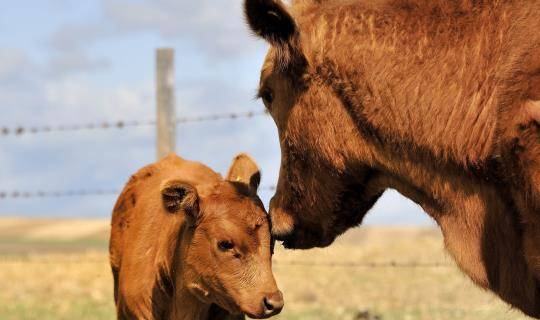Beef-dairy crossbreeding: The next innovation in dairy
By Craig J. Louder, DVM

As dairies become more efficient, milk production has begun to outpace consumer demand. This increased milk production has forced consolidation which leads to a greater need for efficiency. Efficiency then necessitates more innovation and the cycle continues.
Motivation for beef-cross calves
My first exposure to beef-on-dairy-cross animals was shortly after I entered private practice. One of my client herds sold 100 percent of the calves born and bought all of their replacements. For this client, getting the cow pregnant was the only priority in his herd’s reproductive program; there was no need for genetic selection from dairy sires to improve his herd. As more of my clients started breeding for more beefcross calves, they made different management decisions to accommodate their crossbreeding programs.
Using beef semen provides two primary benefits: 1) Improved conception rates and 2) premiums for calves. The calf premium is often the major factor motivating dairies to use beef semen on dairy cows. Companies that produce commercially available purebred beef embryos that can be implanted into dairy cows exist, and in some situations, those calves command an even higher premium.
A new mindset
Milk will always be the primary product marketed by dairies; however, implementing beef semen for breeding creates a lucrative secondary product. It takes a new mindset to really maximize those possibilities.
Consider the following simplified economic analysis: A cow that produces 25,000 pounds of milk produces 250 hundredweight (cwt) of milk. If milk is $18/cwt and the breakeven is $16, the cow should net roughly $500 per lactation. With a premium of $150 on a beefcross calf, the calf represents a 30 percent increase in revenue generated by the cow for that lactation.
This paradigm shift of producing more than milk also requires a shift in reproductive management and bull selection. Some of the management decisions to consider: fertility, carcass traits, calving ease, and calf management.
Fertility
One of the major benefits of using beef semen is the improved conception rate. Many bull studs use a fertility rating for the bulls in their lineup. Due to hybrid vigor, crossing beef bulls with dairy cows maximizes the bulls’ fertility. By ensuring these cows get pregnant, we can lessen the demand for more replacement heifers because these cows that breed up are able to stay in the herd for additional lactations.
Some people would argue that our highest genetic potential is in our younger animals; however, if we cull those animals before their third lactation, we never realize that genetic potential. Assuring that these animals are able to get pregnant from these beef bulls and progress to maturity will ensure increased production from a more mature herd.
Carcass traits
When selecting beef bulls, the focus moves from traits that maximize milk production to traits that maximize meat production. The best beef cows convert their feed to fat and muscle. The result is a difference in the shape of the muscle on the carcass. Just as dairy producers select genetics for milk flow and components from bulls to improve their dairy cows’ marketable product, they must also select bulls that will improve the carcass characteristics of their beef calves.
Traditionally, dairy animals have had high levels of intramuscular fat or marbling, but have had smaller or flatter muscle expression. Looking at bulls with larger ribeye areas and other carcass traits will help to compensate where dairy carcasses are generally weak.
While certain beef breeds produce calves that are easily identified at birth as beef crosses, some matings can be difficult to identify as beef crosses at birth, especially for inexperienced workers.

Calving ease

Certain crosses have a tendency to generate bigger calves than others. While it is important to always be aware of calving-ease selection, with more crossbred dairy cows being bred to beef bulls, the possibility of having a large birthweight calf is a continual risk.
Mark these cows as carrying a beef-cross calf to help workers become alert to this risk and able to intervene sooner. Employees and other dairy personnel must receive proper training and equipment. Quality OB chains or straps and lubricant can be the difference between a live calf and a dead cow.

Calf management
Colostrum. Colostrum management is one of the most important factors in getting a calf off to a healthy start. For many dairies, heifers have priority on receiving colostrum. With calf ranches paying a $100–$150 premium over Holstein bull calves, buyers are not going to continue to pay premiums for calves that are high risk due to poor colostrum intake. Utilization of colostrum supplements or replacers can help fill the gaps created from insufficient production of quality colostrum.
Identification. Beef producers are generally familiar with “terminal crosses” — animals bred to not be used as replacement breeding animals in a herd. In these herds, ranchers develop mechanisms to identify these animals so they can sell them at the appropriate time, therefore not retaining them for breeding. Historically, dairy producers bred for replacement animals, so the need to manage a “terminal animal” was not considered. With the cost of developing heifers, it is important that beef-on-dairy-cross calves are correctly identified so that these animals are managed correctly and do not end up in the lactating herd.
While certain beef breeds produce calves that are easily identified at birth as beef crosses, some matings can be
difficult to identify as beef crosses at birth, especially for inexperienced workers. You should always maintain records of breedings; an on-cow identification system can help facilitate identification of calves at birth.
One herd that started putting in beef embryos would put in a red tag with “embryo” written on the tag when the cow was pregnant. Since the herd’s regular identification tags were yellow, the red tag immediately alerted workers in the maternity pens to correctly identify the calves when they were born with their own “embryo”-marked neck chain. Many feedlot tags are less expensive and come in multiple colors; you can easily purchase them to facilitate this method.
Efficiency has forced the dairy industry to evolve over the past 100 years and the beef cross is the next evolution that can provide dairies with improved profitability. Consideration of minor management changes can help with the implementation of this profitable enterprise.





